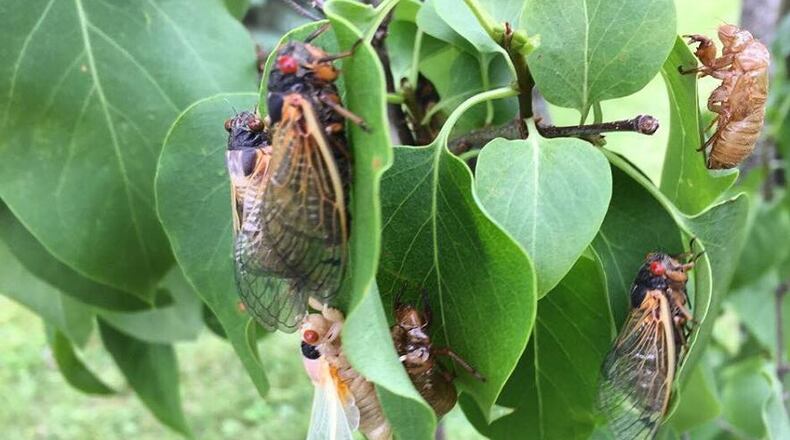Other broods have emerged at other times around Ohio. The last time Brood X emerged was 2004. Brood X will also emerge in parts of Pennsylvania, Michigan, Maryland and Indiana, according to the National Forest Service.
“They’re really a kind of a wild spectacle of nature,” said Don Cipollini, a professor of biological sciences at Wright State University.
There are so many of them as a species survival strategy, he said. These native insects are clunky fliers and easy prey. But if billions of them show up, even if millions get eaten, there are still plenty of cicadas left over to mate and lay eggs again.
But the amount of cicadas also means their singing can be loud.
“If you’re close to a wooded area, when they’re really singing and coordinating, it’s deafening,” Cipollini said.
Dogs can also get sick from eating too many of the insects at once, said Gene Kritsky, dean of the School of Behavioral and Natural Sciences at Mount St. Joseph University. He has written multiple books on periodical cicadas.
The insects will lay their eggs in twigs or thin branches on trees, so it helps to put fine mesh netting around very young or very small trees if you are worried that the tree would be impacted.
Joe Boggs, an assistant professor at Ohio State University, said he had never seen a tree be killed by the damage from insects, but small trees that have been planted in the last few years could get seriously harmed by egg-laying.
“Smaller trees, trees that have been planted in the last few years, there may be enough damage for those trees to have some long-term harm,” he said.
Boggs suggested waiting to wrap trees until the cicadas emerge in their area, since there aren’t good predictions of when the cicadas will emerge exactly. Cicadas can be abundant in one area, but a mile away there may be none.
He said the cicadas need established trees to emerge, so they are more likely to show up in metroparks or cemeteries.
Until they emerge from the ground, the cicadas are in a larvae stage underground, Cipollini said. They eat fluids that run through the vascular system of primarily trees, he said, and emerge from the ground to mate, lay eggs and die.
Cipollini said he doesn’t recommend spraying around the time cicadas are there, because they are harmless and will leave quickly.
Kritsky said data showing where cicadas will emerge is incomplete. He uses an app called Cicada Safari and asks the general public to submit photos of periodical cicadas and the location of the photo when they show up to track the cicadas.
Periodical cicadas only fly about a mile from where they crawl out of the ground to lay eggs, Kritsky said.
Boggs said some people call these insects locust, but that’s not accurate. Locusts are a type of grasshopper. The cicadas don’t behave the way locust do, he said. He said they eat some plants, but don’t eat everything in sight.
Kritsky said he was excited to see the cicadas emerge and to continue the research he had been doing with the periodical cicadas. Deforestation and climate change have been impacting the periodical cicadas, he said.
“The world would not be as neat of a place if we didn’t have monarchs and periodical cicadas,” Kritsky said.
About the Author

